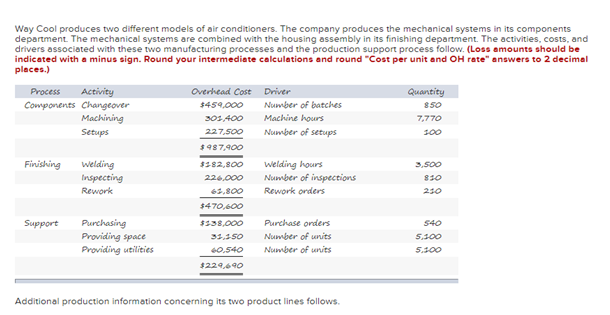
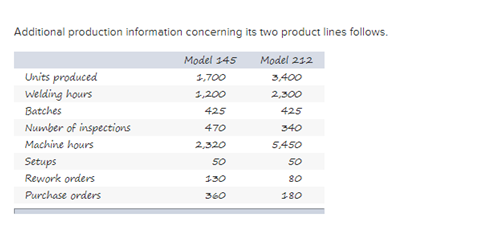
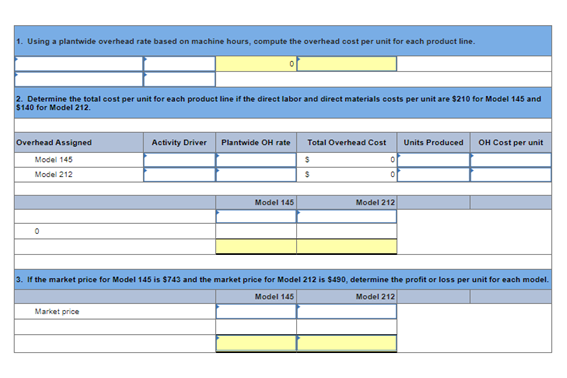
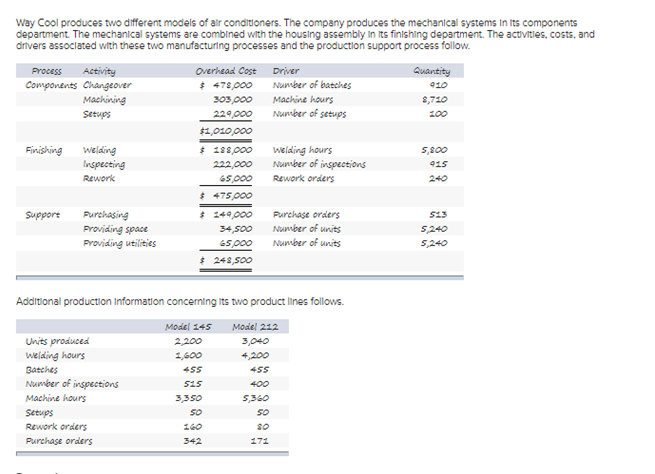

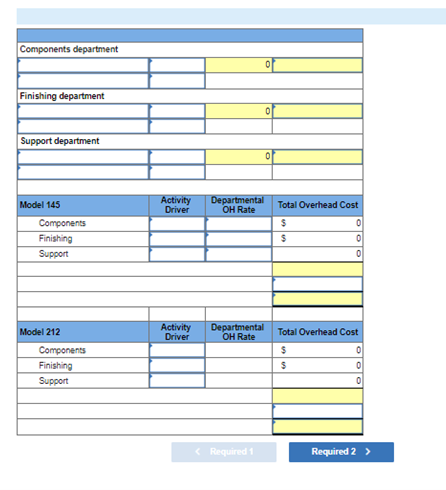
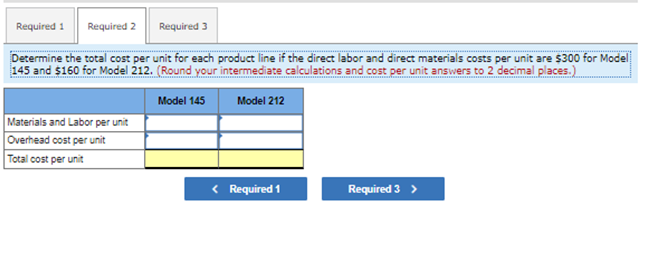
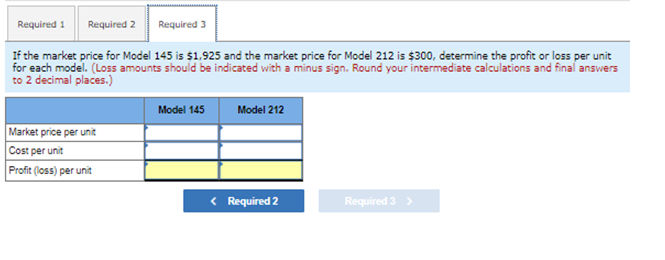


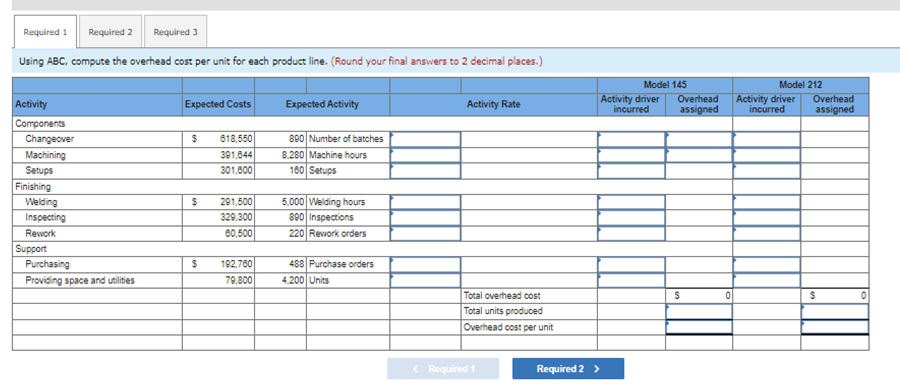


Way Cool produces two different models of air conditioners. The company produces the mechanical systems in its components department. The mechanical systems are combined with the housing assembly in its finishing department. The activities, costs, and drivers associated with these two manufacturing processes and the production support process follow. (Loss amounts should be indicated with a minus sign. Round your intermediate calculations and round "Cost per unit and OH rate" answers to 2 decimal places.) Process Activity Overhead Cost Driver Quantity Components Changeover $459.000 Number of batches 850 Machining 303,400 Machine hours 7,770 Setups 227.500 Number of setups 300 $487,900 Finishing Welding 33 82,800 Welding hours 3,500 Inspecting 226.000 Number of inspections 830 Rework 63.800 Rework orders 230 $470.600 Support Purchasing $338,000 Purchase onders 540 Providing space 3.350 Number of units S.JOO Providing utilities 60.540 Number of units 5.100 $229,640 Additional production information concerning its two product lines follows. Additional production information concerning its two product lines follows. Units produced Welding hours Batches Number of inspections Machine hours Setups Rework orders Purchase orders Model 345 3.700 3,200 425 470 2.320 50 130 360 Model 232 3,400 2.300 425 340 5,450 50 80 380 1. Using a plantwide overhead rate based on machine hours, compute the overhead cost per unit for each product line. 2. Determine the total cost per unit for each product line if the direct labor and direct materials costs per unit are $210 for Model 145 and $140 for Model 212 Activity Driver Plantwide OH rate Units Produced OH Cost per unit Overhead Assigned Model 145 Model 212 Total Overhead Cost $ $ 0 0 Model 145 Model 212 0 3. If the market price for Model 145 is $743 and the market price for Model 212 is $490, determine the profit or loss per unit for each model. Model 145 Model 212 Market price Way Cool produces two different models of air conditioners. The company produces the mechanical systems in its components department. The mechanical systems are combined with the housing assembly in its finishing department. The activities, costs, and drivers associated with these two manufacturing processes and the production support process follow. Process Activity Overhead Cost Driver Quantity Components Changeover $ 478.000 Number of batches Machining 303,000 Machine hours 8,720 Setups 229.000 Number of setups 200 $1,010 000 Finishing Welding $288.000 Welding hours 5,800 Inspecting 222.000 Number of inspections 915 Rework 65,000 Rework orders $ 475.000 Support Purchasing $ 249000 Purchase orders 513 Providing space 34,500 Number of units 5.240 Providing utilities 65.000 Number of units 5.240 $ 248,500 Additional production Information concerning its two product lines follows. Units produced Welding hours Batches Number of inspections Machine hours Setups Rework orders Purchase orders Model 145 2 200 1,600 455 525 3,350 so Model 212 3,040 4.200 455 400 5,360 so so 273 342 Required: 1. Determine departmental overhead rates and compute the overhead cost per unit for each product line. Base your overhead assignment for the components department on machine hours. Use welding hours to assign overhead costs to the finishing department. Assign costs to the support department based on number of purchase orders. 2 Determine the total cost per unit for each product line of the direct labor and direct materials costs per unit are $300 for Model 145 and $160 for Model 212 3. If the market price for Model 145 is $1.925 and the market price for Model 212 is $300. determine the profit or loss per unit for each model. Components department Finishing department 0 Support department Model 145 Activity Driver Departmental OH Rate Components Finishing Support Total Overhead Cost $ 0 $ 0 0 Activity Driver Departmental OH Rate Total Overhead Cost Model 212 Components Finishing Support $ $ Required 1 Required 2 Required 3 Determine the total cost per unit for each product line if the direct labor and direct materials costs per unit are $300 for Model 145 and 5160 for Model 212. (Round your intermediate calculations and cost per unit answers to 2 decimal places.) Model 145 Model 212 Materials and Labor per unit Overhead cost per unit Total cost per unit Required 1 Required 2 Required 3 If the market price for Model 145 is $1,925 and the market price for Model 212 is $300, determine the profit or loss per unit for each model. (Loss amounts should be indicated with a minus sign. Round your intermediate calculations and final answers to 2 decimal places.) Model 145 Model 212 Market price per unit Cost per unit Profit (loss) per unit 160 Way Cool produces two different models of air conditioners. The company produces the mechanical systems in its components department. The mechanical systems are combined with the housing assembly in its finishing department. The activities, costs, and drivers associated with these two manufacturing processes and the production support process follow. Process Activity Overhead Cost Driver Quantity Components Changeover $ 618,SSO Number of batches 890 Machining 392,644 Machine hours 8,280 Setups 302,600 Number of setups $1,311,744 Finishing Welding $ 292,500 Welding hours 5,000 Inspecting 329,300 Number of inspections Rework GO,500 Rework orders $ 692,300 Support Purchasing $ 192,760 Purchase orders Providing space 32,400 Number of units 4.200 Providing utilities 48,400 Number of units $ 272,560 220 488 Additional production Information concerning its two product lines follows. Model 145 Model 212 Units produced 1,400 2,800 Welding hours 1.200 3,800 Batches Number of inspections 400 Machine hours 2,950 5,330 Setups 80 80 Rework orders 160 GO Purchase orders 163 445 445 325 Required: 1. Using ABC, compute the overhead cost per unit for each product line. 2 Determine the total cost per unit for each product line of the direct labor and direct materials costs per unit are $220 for Model 145 and $114 for Model 212. 3. If the market price for Model 145 is $970.56 and the market price for Model 212 is $548.62, determine the profit or loss per unit for each model. Required 1 Required 2 Required 3 Using ABC, compute the overhead cost per unit for each product line. (Round your final answers to 2 decimal places.) Expected Costs Expected Activity Activity Rate Model 145 Activity driver Overhead incurred assigned Model 212 Activity driver Overhead incurred assigned $ 618.550 391.844 301.800 890 Number of batches 8.280 Machine hours 160 Setups Activity Components Changeover Machining Setups Finishing Welding Inspecting Rework Support Purchasing Providing space and utilities $ 291.500 329,300 80,500 5,000 Welding hours 890 Inspections 220 Rework orders $ 192.780 79,800 488 Purchase orders 4.200 Units S 0 S Total overhead cost Total units produced Overhead cost per unit Required 1 Required 2 > Determine the total cost per unit for each product line if the direct labor and direct materials costs per unit are $220 for Model 145 and 5114 for Model 212. (Round your final answers to 2 decimal places.) Model 145 Model 212 Materials and Labor per unit Overhead cost per unit Total cost per unit if the market price for Model 145 is $970.56 and the market price for Model 212 is $548.62, determine the profit or loss per unit for each model. (Round your final answers to 2 decimal places.) Model 145 Model 212 Price per unit Cost per unit Profit (loss) per unit



















